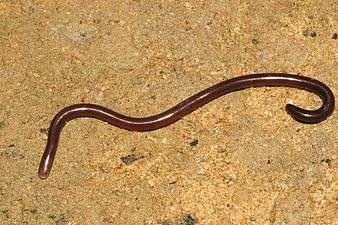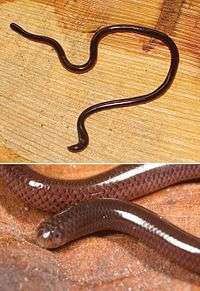Indotyphlops braminus
Indotyphlops braminus, commonly known as the brahminy blind snake[3] and other names, is a nonvenomous blind snake species found mostly in Africa and Asia, but has been introduced in many other parts of the world. They are completely fossorial (i.e., burrowing) animals, with habits and appearance similar to earthworms, for which they are often mistaken, although close examination reveals tiny scales rather than the annular segments characteristic of true earthworms. The specific name is a Latinized form of the word Brahmin, which is a varna (caste) among Hindus. No subspecies are currently recognized.[3]
| Indotyphlops braminus | |
|---|---|
 | |
| Scientific classification | |
| Kingdom: | Animalia |
| Phylum: | Chordata |
| Class: | Reptilia |
| Order: | Squamata |
| Suborder: | Serpentes |
| Family: | Typhlopidae |
| Genus: | Indotyphlops |
| Species: | I. braminus |
| Binomial name | |
| Indotyphlops braminus (Daudin, 1803) | |
| Synonyms | |
| |
Description

Adults measure 2–4 inches (5.1–10.2 cm) long, uncommonly to 6 inches (15 cm), making it the smallest known snake species. The head and tail are superficially similar as the head and neck are indistinct. Unlike other snakes, the head scales resemble the body scales. The eyes are barely discernible as small dots under the head scales. The tip of the tail has a small, pointed spur. Along the body are fourteen rows of dorsal scales. Coloration ranges from charcoal gray, silver-gray, light yellow-beige, purplish, or infrequently albino, the ventral surface more pale. Coloration of the juvenile form is similar to that of the adult. Behavior ranges from lethargic to energetic, quickly seeking the cover of soil or leaf litter to avoid light[4][5][6]
The tiny eyes are covered with translucent scales, rendering these snakes almost entirely blind. The eyes cannot form images, but are still capable of registering light intensity.
Common names
I. braminus is variously known as brahminy blind snake (or brahminy blindsnake),[3] flowerpot snake, common blind snake, island blind snake,teliya snake, and Hawaiian blind snake. The moniker "flowerpot snake" derives from the snake's incidental introduction to various parts of the world through the plant trade.
Geographic range
Probably originally native to Africa and Asia, it is an introduced species in many parts of the world, including Australia, the Americas, and Oceania. It is common as an introduced species throughout most of Florida now.[7]
The vertical distribution is from sea level to 666 m in Sri Lanka and up to 1000 m in Utopia. The type locality given is "Vishakhapatam" [India].[1]
This is also the only snake reported from the Lakshadweep Islands.[8]
Indigenous
In Africa, it has been reported in Egypt, Kenya, Senegal, Benin, Togo, Ivory Coast, Cameroon, Zimbabwe, Somalia, Zanzibar, Tanzania, Mozambique, South Africa (an isolated colony in Cape Town, also about eight have been found in Lephalale, Limpopo Province at the Medupi Power Station during construction), Madagascar, the Comoro Islands, Mauritius, the Mascarene Islands and the Seychelles. In Asia, it occurs on Arabian Peninsula, Iran, Pakistan, Nepal, mainland India, the Maldives, the Lakshadweep Islands, Sri Lanka, Bangladesh, the Andaman Islands, the Nicobar Islands, Myanmar, Singapore, the Malay Peninsula, Thailand, Cambodia, Vietnam, Laos, Hainan, southern China, Hong Kong, Taiwan, and the Ryukyu Islands of Okinawashima and Miyakoshima.
In Maritime Southeast Asia, it occurs on Sumatra and nearby islands (the Riao Archipelago, Bangka, Billiton and Nias), Borneo, Sulawesi, the Philippines, Butung, Salajar, Ternate, Halmahera, Buru, Ceram, Ambon, Saparua, Java, Bali, Lombok, Sumbawa, Madura, Flores, Lomblen, Sumba, Timor, East Timor, Kai Island, the Aru Islands,[9] New Guinea (Western Papua and Papua New Guinea), New Britain, and Bougainville Island.
It occurs in the Cocos (Keeling) Islands, and on Christmas Island.
Introduced
They have been introduced mainly to control the spreading of termites in the following countries.
In Australia, it occurs in the Northern Territory near Darwin, and at the northern tip of Queensland and other parts of queensland like sunshine coast.
In Oceania, it occurs on Palau, Guam, Fiji, Saipan, Hawaiian Islands and Tahiti in French Polynesia.
In the Americas, it occurs in the United States (California, Connecticut, Florida, Louisiana, Massachusetts, Arizona, Hawaii and Texas), western and southern Mexico, Guatemala, Colombia, Barbados and on the Cayman Islands, Turks and Caicos Islands.
It has been found in the Canary Islands of Tenerife and Gran Canaria, probably being introduced in soil imported with potted plants.[10]
Habitat
Usually, they occur in urban and agricultural areas.[4] These snakes live underground in ant and termite nests. They are also found under logs, moist leaves, stones and humus in wet forest, dry jungle, abandoned buildings and even city gardens. The distribution and survival of this group of blind snakes directly reflect soil humidity and temperature.[8]
Feeding
Their diet consists of the larvae, eggs, and pupae of ants and termites.[4]
Reproduction
This species is parthenogenetic and all specimens collected so far have been female. They lay eggs or may bear live young. Up to eight offspring are produced - all female and all genetically identical.[4]
It has been proposed that the species be transferred to a new genus as Virgotyphlops braminus because of its obligate parthenogenetic nature.[11]
References
- McDiarmid RW, Campbell JA, Touré TA. 1999. Snake Species of the World: A Taxonomic and Geographic Reference, Volume 1. Washington, District of Columbia: Herpetologists' League. 511 pp. ISBN 1-893777-00-6 (series). ISBN 1-893777-01-4 (volume).
- The Reptile Database. www.reptile-database.org.
- "Ramphotyphlops braminus". Integrated Taxonomic Information System. Retrieved 30 August 2007.
- Brahminy Blind Snake at the Florida State Museum of Natural History. Accessed 30 August 2007.
- Brahminy Blind Snake One of the Worlds Smallest Snake
- The one of the smallest snake in the world
- U.Florida.edu—Herpetology: Ramphotyphlops braminus
- Whitaker R. 1978. Common Indian Snakes: A Field Guide. Chennai: Macmillan India Limited. 154 pp. ISBN 978-0333901984.
- Aru Islands: requires confirmation according to McDowell, 1974:25
- John Bowler (2018). Wildlife of Madeira and the Canary Islands. Wild Guides. p. 164. ISBN 9780691170763.
- Wallach, Van (2020). "First appearance of the Brahminy Blindsnake, Virgotyphlops braminus (Daudin 1803) (Squamata: Typhlopidae), in North America, with reference to the states of Mexico and the USA" (PDF). IRCF Reptiles & Amphibians. 27 (2): 326–330.
Further reading
- Annandale N. 1906. Notes on the fauna of a desert tract in southern India. Part I. Batrachians and reptiles, with remarks on the reptiles of the desert region of the North-West Frontier. Mem. Asiatic Soc. Bengal, Calcutta 1: 183-202.
- Boulenger GA. 1893. Catalogue of the Snakes in the British Museum (Natural History). Volume I., Containing the Families Typhlopidæ ... London: Trustees of the British Museum (Natural History). (Taylor and Francis, printers). xiii + 448 pp. + Plates I-XXVIII. (Typhlops braminus, pp. 16–17).
- Daudin FM. 1802. Histoire Naturelle, Générale et Particulière des Reptiles. Tome septième [Volume 7]. Paris: F. Dufart. 436 pp.
- Hedges SB, Marion AB, Lipp KM, Marin J, Vidal N. 2014. A taxonomic framework for typhlopid snakes from the Caribbean and other regions (Reptilia, Squamata). Caribbean Herpetology (49): 1-61. (Indotyphlops braminus, new combination).
- Jones GS, Thomas LA, Wong K. 1995. "Ramphotyphlops braminus ". Herpetological Review 26 (4):210-211.
- Kelaart EF. 1854. Catalogue of reptiles collected in Ceylon. Ann. Mag. Nat. Hist., Second Series 13: 137-140.
- Kraus F, Carvalho D. 2001. The Risk to Hawai'i from Snakes. Pacific Science 55 (4): 409-417. PDF at University of Hawai'i press. Accessed 20 April 2008.
- Nussbaum RA. 1980. The brahminy blind snake (Ramphotyphlops braminus) in the Seychelles Archipelago: Distribution, variation, and further evidence for parthenogenesis. Herpetologica 36 (3): 215-221.
- Oliver JA, Shaw CE. 1953. The amphibians and reptiles of the Hawaiian Islands. Zoologica, New York 38 (5): 65-95.
- O'Shea M, Halliday T. 2002. Smithsonian Handbooks: Reptiles and Amphibians. London: DK Publishing. 256 pp. ISBN 0-7894-9393-4.
- Ota H, Hikida T, Matsui M, Mori A, Wynn AH. 1991. Morphological variation, karyotype and reproduction of the parthenogenetic blind snake, Ramphotyphlops braminus, from the insular region of East Asia and Saipan. Amphibia-Reptilia 12: 181-193.
- Owen R, Bowman DT Jr, Johnson SA. 1998. "Geographic Distribution. Ramphotyphlops braminus ". Herpetological Review 29 (2): 115.
- Palmer, DD and RN Fisher. 2010. "Geographic Distribution. Ramphotyphlops braminus ". Herpetological Review 41 (4): 518.
- Thomas LA. 1997. "Geographic Distribution. Ramphotyphlops braminus ". Herpetological Review 28 (2): 98.
- Vijayakumar SP, David P. 2006. Taxonomy, Natural History, And Distribution Of The Snakes Of The Nicobar Islands (INDIA), Based On New Materials And With An Emphasis On Endemic Species. Russian Journal of Herpetology 13 (1): 11 – 40.
- Wall F. 1919. Notes on a collection of Snakes made in the Nilgiri Hills and the adjacent Wynaad. J. Bombay Nat. Hist. Soc. 26: 552-584.
- Wallach V. 1999. "Geographic distribution: Ramphotyphlops braminus ". Herpetological Review 30 (4): 236.
- Wynn AH, Cole CJ, Gardner AL. 1987. "Apparent Triploidy in the Unisexual Brahminy Blind Snake, Ramphotyphlops braminus ". American Museum Novitates 2868: 1-7.
External links
| Wikimedia Commons has media related to Indotyphlops braminus. |
- Indotyphlops braminus at the Reptarium.cz Reptile Database. Accessed 30 August 2007.
- Image of Ramphotyphlops braminus at the Institute of Toxicology and Genetics. Accessed 30 August 2007.
- Ramphotyphlops braminus at Snakes of Japan. Accessed 30 August 2007.
- Ramphotyphlops braminus at WildHerps.com. Accessed 30 August 2007.
- R. braminus at ThailandSnakes.com. Accessed 22 December 2014.